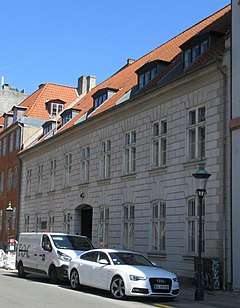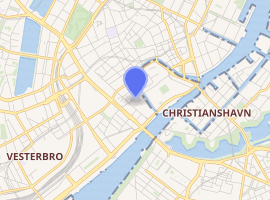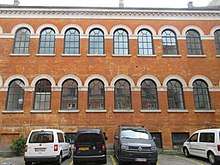Ny Vestergade 11
Ny Vestergade 11 is an 18th-century building located across the street from the main entrance to the National Museum in central Copenhagen, Denmark. The University of Copenhagen the building in 1857 and it was subsequently adapted for use as a new Chemical Laboratory. It was later home to August Krogh's Laboratory of Animal Laboratory between 1910 and 1928. He and his wife, {{Marie Krogh[[, who was part of his staff, had an apartment in the building. A plague on the facade commemorates that August Krogh lived in the building when he was awarded the Nobel Prise in 1920. The building was listed in the Danish Registry of Protected Buildings and Places in 1932.
| Nt Vestergade 11 | |
|---|---|
 | |

| |
| General information | |
| Architectural style | Neoclassical |
| Location | Copenhagen |
| Country | Denmark |
| Coordinates | 55°40′25.14″N 12°34′34.72″E |
| Completed | 1821 |
| Renovated | 1858 |
| Design and construction | |
| Architect | Johan Henrik Nebelong |
History
.jpg)
The building was constructed as a combined storage house and stables for grocer I. Lund in 1821.[1]
The University of Copenhagen acquired the building in 1857 and commissioned Johan Henrik Nebelong to adapt it for its new use as a Chemical Laboratory.[2] The new Chemical Laboratory was inaugurated in a new side wing in 1859. A residence for professpr Julius Thomsen was also located in the complex. The Chemical Laboratory remained at the site until 1892.[3]
The building was in 1910 used by the university for a new Laboratory of Animal Physiology created specially for August Krogh. His wife, Marie Krogh, was part of his staff. They also took over the residence. The premises were also used for sports physiological research carried out in collaboration with Johannes Lindhard . A delegation from the Rockefeller Foundation visited Krogh's laboratory in 1924 and ended up making a US§ 300,000 donation for a new building for August Krogh and four other laboratories at the university.The Carlsberg Foundation donated an addition DKK for the project. Krogh's laboratory left Ny Vestergade 11 when the Rockefeller Complex was inaugurated in 1928.[4]
Architecture

The building consists of two and is nine bays long. A memorial plaque commemorates that August Krogh lived and worked in the building from 1910 until 1927.[5]
Today
The building is now used by the National Museum.
Further reading
- Larsen, Erik Hviid: August Krogh og Dyrefysiologisk Laboratorium i Ny Vestergade 11, Ugeskrift for Læger, No. 51 (2001)
References
- "Ny Vestergade 11" (in Danish). indenforvoldene.dk. Retrieved 20 February 2020.
- "Sag: Ny Vestergade 11" (in Danish). Kulturstyrelsen. Retrieved 20 February 2020.
- "En kemisk byvandring i København" (in Danish). Dansk Kemi. Retrieved 20 February 2020.
- "August Krogh og Rockefeller Komplekset" (in Danish). Biokemisk Forening. Retrieved 20 February 2020.
- "Mindetavle for August Krogh" (in Danish). Københavns Biblioteker. Retrieved 20 February 2020.
External links
| Wikimedia Commons has media related to Ny Vestergade 11. |